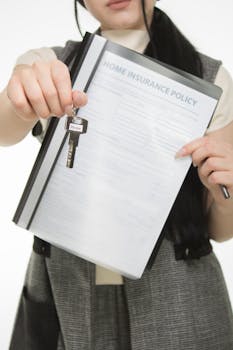Home Insurance
What Home Insurance Really Covers and What It Doesn’t: Straight Facts for Homeowners
Get the real scoop on home insurance coverage. Find out exactly what’s covered, what is not, and actionable ways to ensure you’re never caught off-guard by a claim.
Advertisement
A tree falls on your roof during a storm and suddenly, you’re wondering what home insurance coverage actually protects you from. It’s a gut-check moment for any homeowner.
Knowing what your policy covers can mean the difference between peace of mind and surprise expenses. Too many homeowners discover their gaps only after disaster strikes—not before.
Delving into the specifics of home insurance coverage reveals far more than blanket promises. Stick with us as we break down what’s covered, what’s excluded, and how to sidestep costly misunderstandings.
Pinpointing the Core Protections Your Policy Provides
Every homeowner will see immediate benefits by understanding what their home insurance coverage guarantees in clear terms. The right knowledge stops confusion during emergencies.
Standard policies generally cover your home’s structure, personal property, and liability for accidents. However, insurance language isn’t always straightforward, so examining policy details matters.
Dwelling and Structural Coverage: What “Walls-In” Means
If lightning damages your siding, dwelling coverage kicks in and pays for repairs. This coverage applies to your roof, walls, floors, and attached garages, but stops at what’s outside your property lines.
Garages, porches, and built-in appliances are included—think everything physically attached to the house. Detached buildings may require additional coverage or endorsements, so check your declarations page for limitations.
The phrase “walls-in” makes sense if you picture literally peeling away everything outside your home’s shell. Anything nailed, screwed, or bolted in is typically included.
Personal Property Protection: What’s Inside Counts Too
Picture a thief grabbing your laptop from your kitchen. Personal property coverage reimburses you after deductibles, typically up to 50-70% of your total dwelling limit.
High-value items—like jewelry, art, or rare collectibles—may face per-item limits. Most homeowners choose to schedule these items after a quick valuation process to avoid out-of-pocket losses.
Your belongings away from home, such as luggage stolen from a hotel room, get partial protection too. Double-check off-premises coverage percentages to avoid headaches during travel mishaps.
| Item | Standard Coverage | Typical Limit | Action Step |
|---|---|---|---|
| Main dwelling | Yes | 100% of dwelling amount | Review annual replacement cost with agent |
| Detached garage/shed | Maybe | 10–20% of main dwelling | Request endorsement if higher value |
| Jewelry | Limited | $1,000 – $5,000 | Schedule appraised items separately |
| Electronics | Yes | Up to personal property limit | Create digital inventory with receipts |
| Landscaping | No | N/A | Add special coverage for expensive trees/plants |
Exclusions To Spot: Losses Your Policy Won’t Cover Automatically
Identifying policy exclusions gives you the power to prepare for situations not covered by home insurance coverage. Failing to note exclusions can lead to surprise costs after a claim.
Insurance policies never cover everything; they’re written to respond only to specific risks defined in your contract. Exclusions exist to help insurers predict costs and keep premiums lower.
Natural Disasters and Deliberate Damage Are Out
Flooding from heavy rains, earthquakes, and other earth movements are never included in a standard home insurance coverage contract. These require dedicated endorsements or separate policies.
Intentional damage, whether caused by the homeowner or someone acting under their instruction, always falls outside of home insurance coverage as well. Insurance only covers accidental, unintended losses.
- Purchase a separate flood insurance policy from the National Flood Insurance Program if you live near rivers or coastal areas—most mortgage lenders mandate this coverage anyways.
- Request an earthquake endorsement if your home resides on or near a fault line, like in California. This expands your protection and can be added to many standard policies.
- Always check for policy language around sewer backups. Many companies offer budget-friendly sewer backup riders to add this important protection, which isn’t included automatically.
- Do not expect standard coverage for acts of war, nuclear hazards, or government seizure of property. These catastrophic risks are specifically excluded for predictability.
- If you intentionally break or burn something to receive a payout, your claim will be denied, and legal action may follow. Insurance protects honest accidents—not intentional fraud.
Natural disaster exclusions are typically printed in bold, near the beginning of most policies, making them easy to spot while reviewing your paperwork.
Wear, Tear, and Neglect Drive Exclusion Decisions
Your home insurance coverage does not replace worn-out siding, aging roofs, or appliances past their prime. Insurers expect homeowners to perform regular maintenance and repairs.
Failing to clean gutters, fix leaks, or prevent mold will lead to denied claims. Home insurance coverage responds only to sudden, accidental events—not gradual deterioration or avoidable issues.
- Keep regular home maintenance logs—like dates for HVAC servicing or roof inspections—for easier claim approvals and to prove responsible ownership in case of any dispute.
- Remove dead trees from your property to prevent damage during storms. If a fallen tree causes damage due to neglect, insurance may limit or deny coverage based on evidence.
- Document plumbing repairs and upgrades with photos and receipts. This proves proactive care and helps expedite any future insurance-related repairs if pipes burst or leak unexpectedly.
- Inspect and maintain your home foundation, especially if you live in an area with shifting soils. Cracks due to settling or poor construction usually aren’t covered repairs.
- Store your home inventory list in the cloud or a fireproof safe to safeguard your records in case of a claim or loss of documents during a house fire or theft.
Wear and tear exclusions keep insurance focused on major events—not routine upkeep. Staying on top of repairs protects your eligibility for smooth claims.
Understanding Your Limits and Deductibles When Disaster Strikes
Interpreting coverage limits and deductibles helps you forecast out-of-pocket expenses before emergencies hit. Limits cap payouts, while deductibles determine how much you pay first.
Choosing the right limits means weighing the replacement cost of your home against what you’re prepared to pay in an emergency. This balance is crucial for stress-free claims.
Calculating Maximum Payouts: When Limits Matter Most
A $250,000 dwelling limit means the maximum the insurer will pay to fully rebuild your home after a covered disaster is $250,000—anything above is on you.
Choosing lower limits lowers your premiums, but it leaves you at risk for uncovered rebuilding expenses. Always compare your home’s current value and materials when updating coverage.
Property values change, so review coverage limits every renewal. Use a home value calculator and adjust upwards if you’ve completed renovations or added square footage since your last policy update.
Deductible Choices Shape Your Share of the Bill
If your policy has a $2,000 deductible and your covered loss totals $10,000, you pay $2,000 out-of-pocket before insurance picks up the remaining $8,000. This out-of-pocket cost applies to each claim.
Higher deductibles can save you money on monthly premiums. Consider what you could easily afford in an emergency—most homeowners find a $1,000 or $2,500 deductible hits the sweet spot.
Some policies allow you to set separate deductibles for wind, hail, or hurricane coverage. Review these carefully when living in disaster-prone regions to avoid sticker shock during storm season.
Personal Liability and Guest Medical: Protecting Yourself from Lawsuits
Gaining clarity on liability and medical coverage prevents financial surprises when guests or strangers are hurt on your property. These features shield you from legal expenses.
If a neighbor slips on your porch or a dog bite injures a passerby, liability portions of home insurance coverage pay for their injuries or damaged property, plus your legal defense costs.
Everyday Examples of Liability Claims
A friend visits and falls down slippery steps. He breaks an arm and sues for medical bills and lost wages. Your liability coverage pays as outlined in your policy.
A stray baseball from your backyard shatters a neighbor’s window, you’re responsible for replacement or repair. Your home insurance coverage limits how much your insurer pays on your behalf.
Once legal bills stack up, even a small lawsuit can drain savings quickly. Make sure your policy limit matches at least your home’s value to avoid personal liability.
Guest Medical Payments: Small Accidents, Fast Settlements
Someone trips on a rug in your entryway and twists an ankle. Medical payments coverage helps with hospital or doctor bills, regardless of fault or lawsuit.
Guest medical coverages are handy for resolving minor incidents without litigation or legal battles. It’s a simple way to show goodwill and keep friendships strong after an accident.
Limits usually range from $1,000 to $5,000. Consider a higher amount if you frequently host gatherings or have features like swimming pools or trampolines.
Making Smart Choices About Your Home Insurance Coverage
Home insurance coverage works best when tailored to your specific risks and home updates. Each section—from main dwelling to personal liability—serves a practical purpose for protecting your lifestyle.
The cost of an uncovered loss can be huge, so taking the time to understand exclusions, limits, and optional endorsements puts you in the driver’s seat. Reviewing, updating, and documenting your coverage supports quicker, smoother claims.
You hold the power to shape your financial protection. Review your home insurance coverage annually, ask questions, and stay proactive to keep your home and peace of mind secure.





